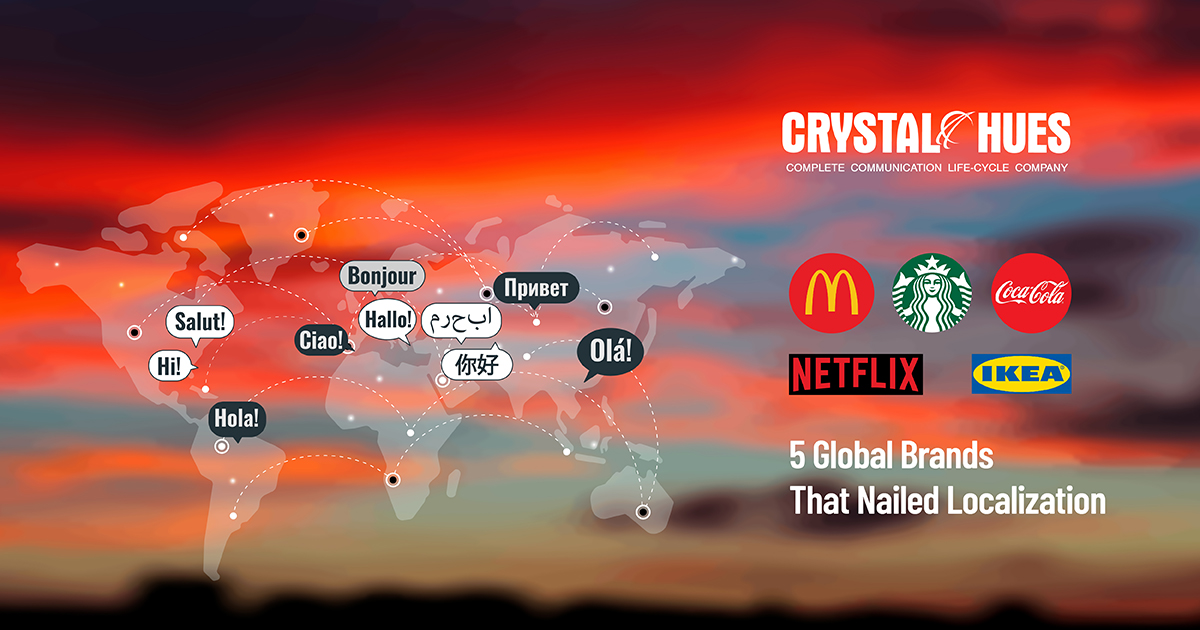
Localization Success Stories: How These 5 Global Brands Nailed Localization
Successful global brands understand one thing better than most: You cannot succeed globally without succeeding locally. Even the most recognizable brand will not sell if it is incompatible with cultural norms, dietary requirements, or social habits.
The most successful international brands are those that took the time to learn about local markets, made a reasonable adjustment to their product offerings, and seamlessly integrated into the new culture without sacrificing their core identity.
In this blog, you will learn how 5 of the biggest brands mastered localization to gain global success.
1. McDonald's India: Taboos to Triumphs
When McDonald's entered India in 1996, they had a huge cultural barrier to hurdle: A vast majority of the Indian population was Hindu, who do not eat beef, and another significant amount was Muslims who do not eat pork. This meant 2 of the 3 products of McDonald's most recognizable products — the Big Mac and the McRib — were not going to work for the strangely-named brand. So how did they navigate this challenge?
Instead of slightly unnaturally altering the menu, they completely re-engineered it from zero.
They added a section of the restaurant that was 100% vegetarian and brought in new products like the spiced potato burger (McAloo Tikki) and Maharaja Mac (chicken substitute for Big Mac).
They even went so far as to change their cooking methods to eliminate cross-contamination between vegetarian and non-vegetarian products. The bet that they placed on vegetarians paid off - 50% or more of the menu is vegetarian now, and the McAloo Tikki alone is nearly 25% of total Indian sales. Now, McDonald's has more than 300 restaurants located in India and is a popular multinational brand that is both global and local.
2. Starbucks in Japan: Blending Beans with Tradition
Starbucks does not simply sell coffee; it sells an experience. But in Japan, which is known for its aesthetic minimalism and tea tradition, the ambient American coffee shop experience wouldn’t work. So, they changed their store formats to be more in line with local architecture and local community attitudes.
One standout example would be their Kyoto Ninenzaka store. The store merges entirely with the surrounding historic neighborhood with its traditional wooden facade and tatami seating.
The Japan menu augmented its offerings as well, introducing themed drinks and desserts, often made from local varieties of Sakura (cherry blossom), matcha, and yuzu as seasonal flavors. The digital interface of the brand was also made local, in terms of a color palette and even symbols, because Japanese users preferred brighter hues and symbols compared to Western users' more muted tones.
The result? Today, Japan is one of Starbucks’ most successful international markets, with over 1,700 locations and featuring some of the brand's most globally released products.
3. Netflix: Creating Content in the Local Language
When Netflix decided to go global with its model, it translated its interface. However, it also had to rethink its entire content strategy. The streaming giant has looked at content from a localized and relevant perspective and recognized that audiences want content that feels relevant to them.
So, what did Netflix do? It invested heavily in original series that reflect a region or taste that is local to that region. Netflix has produced original series in dozens of languages around the world, from Sacred Games in India to the global phenomenon Squid Game in South Korea. They weren't just simply localizing the language but also the plotline, actors, and even the production crew.
Netflix is investing a lot of money in localized content. It claimed to have invested over $1 billion (about $3.1 per person in the US) per year in local content outside of the U.S. and invested in a local production hub in Mexico, South Korea, and India.
In India, Netflix introduced a mobile-only subscription plan for a largely mobile-first user audience that contributed to them accruing over 12 million subscribers.
In FY2024, Netflix India’s year-over-year revenue rose about 49%, which reinforces its localization strategy. Simultaneously, localized content such as Money Heist or Lupin has become globally significant, which demonstrates that local content can enable global conversation.
4. IKEA in Asia: Shrinking Furniture and Expanding Access
IKEA learned that its existing business model was not suited for all global markets. For example, when IKEA entered China, it discovered that its customers were not inclined to assemble their furniture. To respond to this, it began to source from assembly carriers, introduced home-delivery and set-up services, and adjusted store layouts to fit local shopping patterns.
In Japan, famous for the smallness of its apartments, IKEA tested much smaller, "scaled down" furniture lines intended for smaller living environments, and modified its showrooms to reflect Japanese home schemes so they felt more personal. Even its restaurant adjusted by adding dim sum and regional snacks to the menu, while also always serving Swedish meatballs. The outcome has been remarkable.
After breaking with tradition and opening its first city-center store in Tokyo, IKEA Japan saw a 40% year-over-year increase in sales revenue.
5. Coca-Cola: Aligning Names (and Cultures) with Bottles
For years, Coke has enjoyed terrific international branding awareness. However, the shifting consumer landscape, including healthier and trendier drink options for younger consumers, prompted iy to find a new way to connect with potential consumers.
To that end, they created "Share a Coke," an approach where Coke took the logo off bottles and instead inserted popular first names, as well as local nicknames, and let consumers find personal bottles and share them with friends.
"Share a Coke" engaged an aspect of personal connection and social engagement.
The teen consumption in Australia increased by 7% percent, and overall sales saw a 3% increase. The introduction of "Share a Coke" in the U.S. reversed 10 years of declining sales and increased sales by 2.5%.
In total, more than 150 million personalized bottles were sold globally. But Coca-Cola acted on future opportunities, not resting on its success.
They also based bottle sizes, packaging designs, and even sweetness levels on regional preferences, demonstrating that a long-standing brand can still innovate with local twists.
Localization Is an Imperative
These five stories, from McDonald’s, Starbucks, Netflix, IKEA and Coca-Cola, stressed that the way to global success is not in standardization, but in openness to diversity.
Each brand confronted significant cultural or logistical barriers that could have hindered its international goals. Instead, they completed their homework, were receptive to local consumers, and provided offerings that mattered.
Be it a burger that recognizes religious sensibilities, a coffee shop that mimics historic architecture, or a streaming service that focuses on regional stories, these brands proved one thing: going local to go global is the new order.



